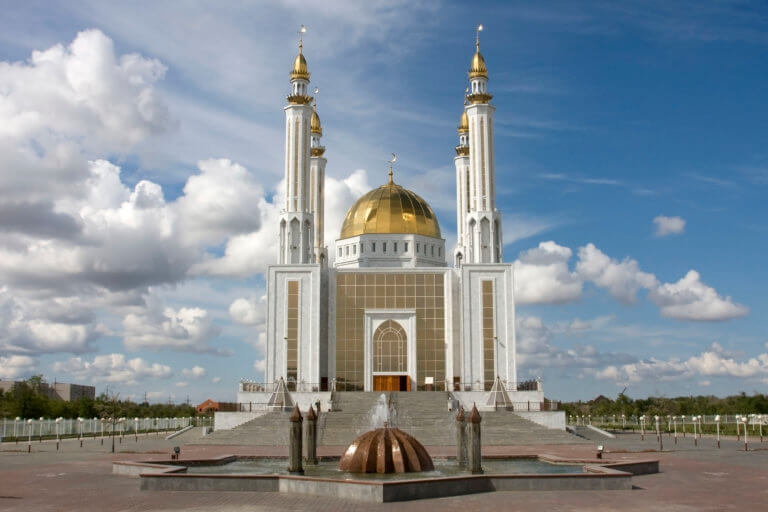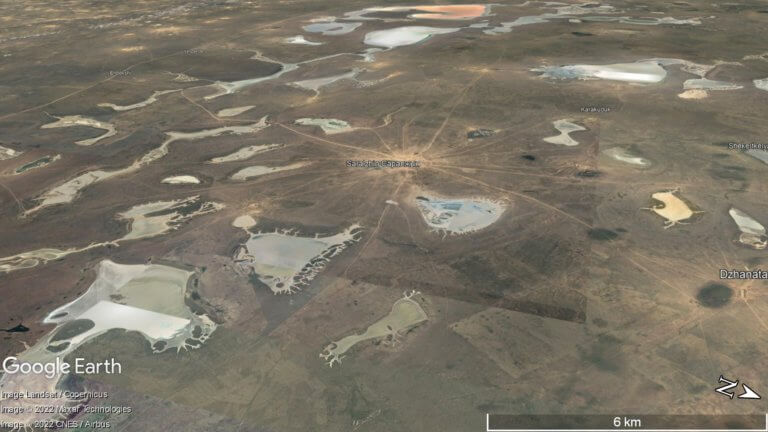
Shalkar Lake
The brackish, egg-shaped Shalkar Lake – 65km south of Oral – measures 15km x 18km and receives water from two rivers on the east side:
Fifteen kilometres north-west of Shetpe town is Ayrakty-Shomanai, or as 19th-century Ukrainian artist-poet Taras Shevchenko preferred to call it during his stay in Mangystau, ‘The Valley of Castles’. The peaks are freestanding, sitting between the Karatau Range to the south and the North Aktau Ridge to the north. Given its otherworldly landscape comprising fin-like rock ridges, soil with colours reminiscent of Venus, and imposing desert spires, it would make a top spot for a sci-fi film. During the Silk Road era, it was an important navigational point for travellers and traders.

From the north side of Ayrkaty-Shomanai it’s possible to drive off road to the summit. Peer over the peak’s east side and, provided they haven’t faded through weathering and erosion, you’ll spot a collection of geoglyphs. However, don’t be fooled! Local archaeologist-historian Andrei Astafiev created these in 2017 to attract more visitors to the area. There are five, with the smallest being a 110m x 150m argali sheep and the largest one depicting a cosmogonic deity measuring 170m x 415m. Astafiev, along with a small team, employed a combination of drones and GPS applications to map out the design meticulously. For construction, they dragged shovels and tools behind a vehicle to churn up the ground. One of their biggest drawings required 30km of driving to complete.
In 2013, a 200-metre-wide pentagram-shaped geoglyph appeared on the outskirts of Aktau. In the same year, another Kazakh pentagram made the headlines on the banks of the Upper Tobol Reservoir in the Kostanay Region. No one’s certain who created these pentagrams, although archaeologist Emma Usmanova believes the Kostanay one is the outline of a star-shaped park from Soviet times. As for the Aktau one, Tengri News says there’s a strong suspicion motorised hang gliders made them.
On some of Ayrakty-Shomanai’s cliffs there are petroglyphs depicting mouflon, horse, camel and dogs. Although, they’re more contemporary and left behind by local herders and hunters. The two most notable rock paintings in the area show a bullet striking a ram and the other one, locally known as the ‘Picture of the World’, shows multiple layers of wild animals.
Shetpe (Şetpe/Шетпе): 44.1388, 52.1688
Ayrakty-Shomanai and Geoglyphs (Airaqty-Şomanai/Айракты-Шоманай): 44.2436, 52.1102
Aktau Pentagram Geoglyph: 43.7293, 51.1283

The brackish, egg-shaped Shalkar Lake – 65km south of Oral – measures 15km x 18km and receives water from two rivers on the east side:

Aktobe is on the western end of the Kazakh Steppe, less than 100km from the Russian border. As the capital city of the Aktobe Region,

At the northern edge of the Ryn Desert is Kamysh-Samara. The 60km x 100km plain was once home to at least a dozen lakes, with